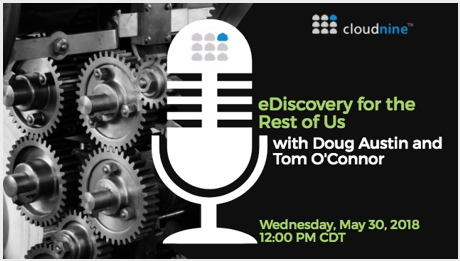eDiscovery for the Rest of Us: eDiscovery Best Practices, Part Four
Editor’s Note: Tom O’Connor is a nationally known consultant, speaker, and writer in the field of computerized litigation support systems. He has also been a great addition to our webinar program, participating with me on several recent webinars. Tom has also written several terrific informational overview series for CloudNine, including eDiscovery and the GDPR: Ready or Not, Here it Comes (which we covered as a webcast), Understanding eDiscovery in Criminal Cases (which we also covered as a webcast), ALSP – Not Just Your Daddy’s LPO and Why Is TAR Like a Bag of M&M’s?. Now, Tom has written another terrific overview regarding eDiscovery for the smaller cases titled eDiscovery for the Rest of Us that we’re happy to share on the eDiscovery Daily blog (and will cover later this month in a webcast). Enjoy! – Doug
Tom’s overview is split into four parts, so we’ll cover each part separately. Part One was published last Tuesday, Part Two was published last Thursday and Part Three was published on Tuesday. Here’s the final part, Part Four.
The EDna Challenge, 2016
In 2016, Craig Ball revisited the Edna challenge with a new set of parameters and a panel at the annual ILTA conference on which I was privileged to be a participant. The panel sought what Craig called “… a re-examination of EDna options circa 2016 on a bigger budget.” https://craigball.net/2016/04/15/edna-still-cheap-and-challenged/ .
In this new challenge, Edna had a Zip file on a thumb drive containing collected ESI in various formats: 10 custodians with ESI PSTs for six of them, four MBOX take outs from Gmail for the other four and a combination of word processed documents, spreadsheets, PowerPoint documents, PDFs and a few scanned paper documents for all ten. She estimated the contents will unzip to about 10-12 GB with somewhere between 50,000 to 100, 000 documents total.
The goal was to conduct a paperless privilege and responsiveness review of the material in-house, sharing the task with an associate and legal assistant. All staff had high-end, big screen desktop PC running Windows 8.1 with MS Office 2016 and Adobe Acrobat 11 Pro installed and the office’s network file server had ample space for the document collection.
The specific goals were:
- Efficient workflow
- Robust search
- Ability to process relevant metadata
- Simple document tagging and production identification
- Effective tracked deduplication
- Review may take up to 90 days, and the case may not conclude for up to two years. All review, hosting and production costs must be borne by the budget.
Edna didn’t own a review tool and was willing to spend up to $5,000.00 total for software, vendor services, SaaS, etc. Craig’s only restrictions on responses were “She won’t spend a penny more. You can’t loan her your systems or software. You can’t talk her out of it. Pricing must mirror real-world availability, not a special deal.”
The good news was that the increase in budget accompanied by the shift to Web based solutions made a dramatic change in the responses. As one independent analyst noted, if kept to 3 months hosting, more than 70% of the companies he worked with could meet the challenge. Brad Jenkins, CEO of CloudNine (the host of this article) noted that the CloudNine software would allow Edna “… access to a complete eDiscovery platform for processing, review, and production. She can upload her data for automated native processing, review her data in CloudNine’s integrated review tool, and produce her data in almost any format.” All for under the limit of the challenge.
What’s Next?
The next step in the market of technology for the rest of us is growth of Internet based tools. We are now seeing even more budget conscious solutions in a SaaS environment, solutions that work with common native format files where you host your own data with programs installed locally that are able to accommodate smaller data collections.
Some of these are well-established companies such as Relativity or Ipro Tech and others are newer companies such as CloudNine, Digital War Room, Logikcull, CS Disco and Everlaw. Some of them also incorporate some form of front-end analytics to significantly reduce the amount of data to be processed as well as TAR or predictive coding technology to enable faster review of documents.
Conclusion
But the ultimate solution is more than just knowing the rules, avoiding e-jargon and understanding the technology. In our estimation, it is the process not the technology.
We are not alone in this appraisal. Technologist John Martin once commented, “It’s the archer not the arrow.” Craig Ball says, “The key consideration is workflow”.
The fact is that technology is not the key to successful management of e-discovery in small cases. Rather, the single most effective way to keep eDiscovery costs low is to work with your opposition in a cooperative manner so you can stipulate to the use of low cost solutions.
We all must change to the new paradigm of working in the digital world. In the words of The Hon. Lee Rosenthal, former Chair of the Standing Committee of the Judicial Conference, “Litigation habits and customs learned in the days of paper must be revisited and revised. The culture of bench and bar must adjust.”
Craig Ball described it as “throwing down the gauntlet in the Edna Challenge when he said, “So, how about it e-discovery industry? Can you divert your gaze from the golden calf long enough to see the future and recall the past? Sam Walton became the richest man of his era by selling to more for less. There’s a fast-growing need…and a huge emerging market. The real Edna Challenge is waiting for the visionaries who will meet the need and serve this market.”
I think we’re very close to being there.
So, what do you think? Do smaller litigation cases get shortchanged when it comes to eDiscovery technology? As always, please share any comments you might have or if you’d like to know more about a particular topic.
Sponsor: This blog is sponsored by CloudNine, which is a data and legal discovery technology company with proven expertise in simplifying and automating the discovery of data for audits, investigations, and litigation. Used by legal and business customers worldwide including more than 50 of the top 250 Am Law firms and many of the world’s leading corporations, CloudNine’s eDiscovery automation software and services help customers gain insight and intelligence on electronic data.
Disclaimer: The views represented herein are exclusively the views of the author, and do not necessarily represent the views held by CloudNine. eDiscovery Daily is made available by CloudNine solely for educational purposes to provide general information about general eDiscovery principles and not to provide specific legal advice applicable to any particular circumstance. eDiscovery Daily should not be used as a substitute for competent legal advice from a lawyer you have retained and who has agreed to represent you.








